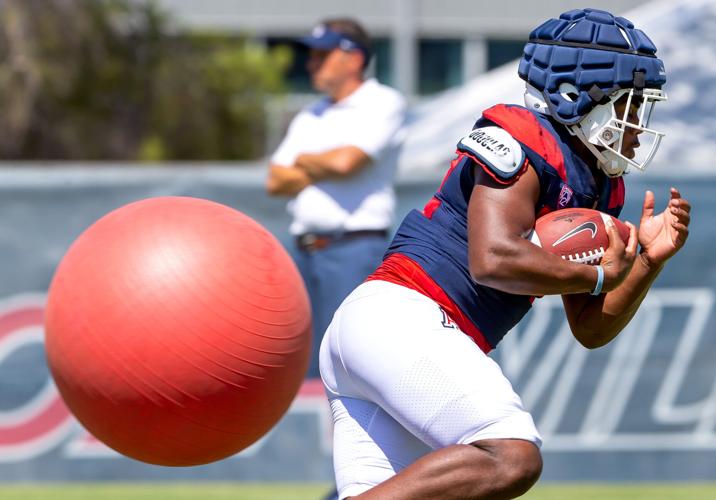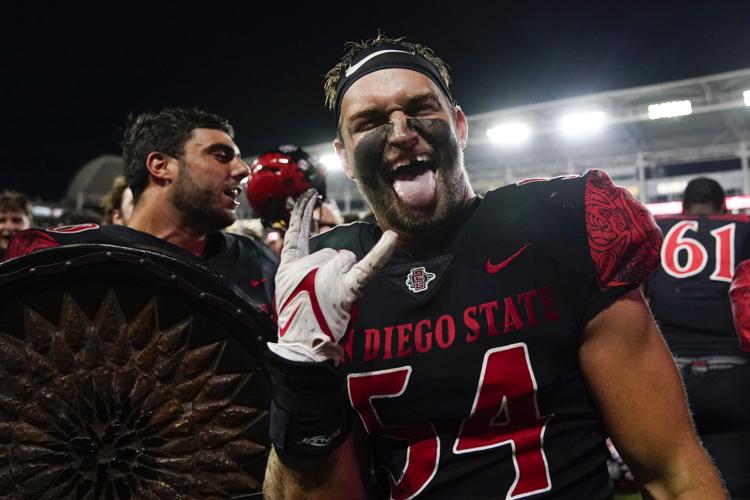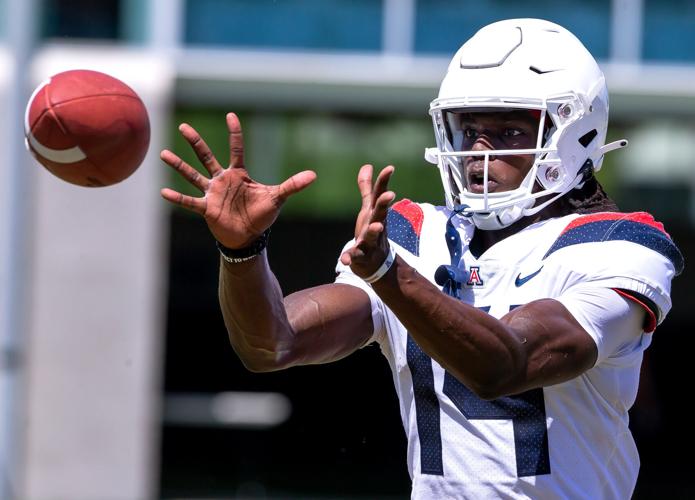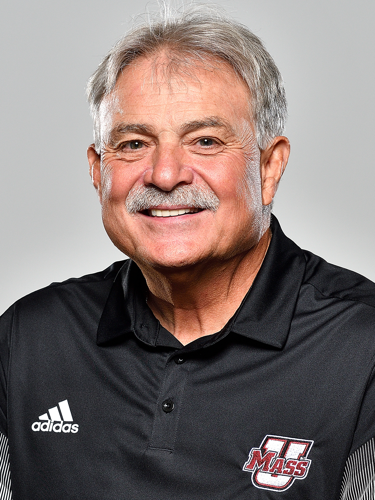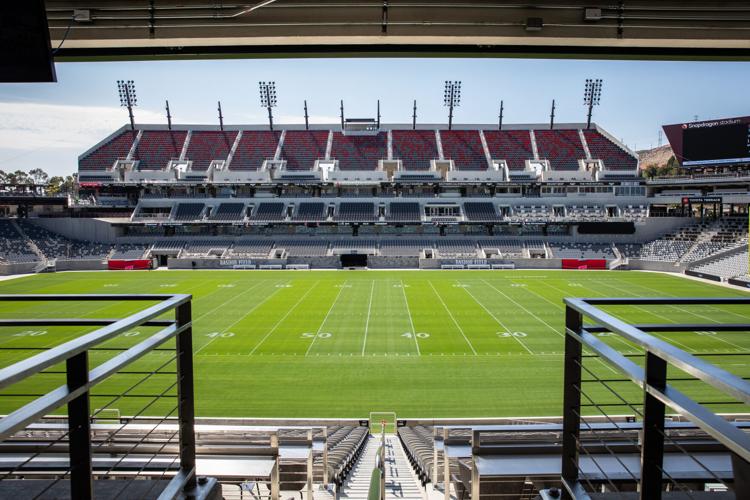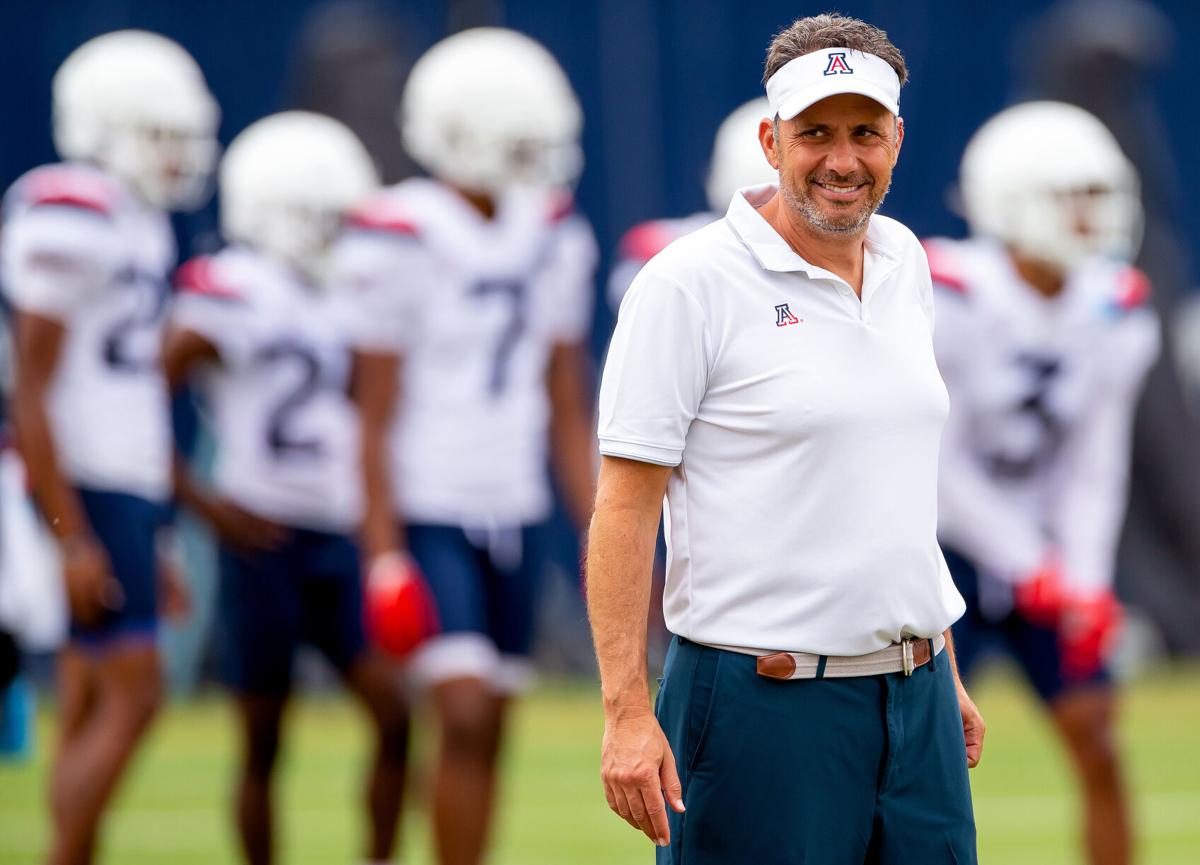Editor's note: This story appeared in the Star's college football special section, released Sunday.
The Star’s longtime columnist breaks down Arizona’s schedule, picks the Pac-12 and summons storylines for the fall:

Arizona running back DJ Williams dodges an exercise ball while running a drill during an Aug. 9 practice on campus.
Breaking away from the bottom feeders
Arizona opens the 2022 season in the least desirable neighborhood in Power 5 football.
Over the past 2½ seasons, Arizona is 1-21. It’s the worst record of any Power 5 school in that period, one that finds the Wildcats linked with Kansas and Vanderbilt, two of the least effective football schools of the last 20 years.
Vanderbilt is 2-20 over the same span. Kansas is 2-19. Next? Duke, that basketball school of basketball schools, has gone 5-18 in football.
The odds of Arizona, Kansas and Vandy moving to a higher-class neighborhood don’t seem promising. Vanderbilt’s three non-conference games are against Elon, Hawaii and Wake Forest. Ordinarily, Vandy might be favored to beat both Elon and Hawaii, but the game against the Rainbow Warriors is in Honolulu. Trouble.
Nor does Kansas seem likely to improve much. The Jayhawks’ nonconference schedule includes home game against Tennessee Tech and Duke and a road game at Houston. Oops.
But none of those schedules compares to the nonconference difficulty of the Wildcats, who open at San Diego State, then play middle-tier SEC school Mississippi State and close the nonconference season against North Dakota State, which is the Alabama of the FCS division.

San Diego State linebacker Caden McDonald celebrates after a 33-31, triple-overtime win over Utah last September.
Pac-12 has been very, very good to Aztecs
When the UA-San Diego State home-and-home series was scheduled five years ago, it didn’t seem unusually difficult. But in that period, the Aztecs have all but toyed with the Pac-12. SDSU has gone 6-2 against Pac-12 teams since 2015. Here’s the log:
2016: SDSU defeats Cal, 45-40.
2017: SDSU defeats ASU, 30-20.
2017: SDSU defeats No. 19 Stanford, 20-17.
2018: SDSU defeats No. 23 ASU, 28-21.
2018: SDSU loses to No. 13 Stanford, 31-10.
2020: SDSU loses to Colorado, 20-10.
2021: SDSU defeats Arizona, 38-14.
2021: SDSU defeats No. 15 Utah, 33-31.
If this has been an audition to join the soon-to-be Pac-10, it has been impressive. The Aztecs play 11 games against Pac-12 schools through 2027, including home-and-home series with Cal, UCLA and Oregon State — although the 2026 game against UCLA might be iffy given the Bruins' move to the Big Ten.

Safety DJ Warnell Jr. is one of two players to transfer to Arizona from UCLA this offseason.
Transfer portal has worked for Arizona
A dozen 2021 Arizona Wildcats entered the transfer portal and have settled at new schools. None of them appear to have upgraded their location.
Those 12 players are now at Grambling, UC Davis, Nevada, Boston College, Adams State, UCF, Montana State, Jacksonville State, Marshall and Toledo. Two are at Hawaii.
Three Arizona players to enter the transfer portal have yet to announce their new school. They include receiver Tayvian Cunningham, who had ACL surgery and is not yet cleared to play; Alex Navarro-Silva and Zach Williams.
By comparison, Arizona this year imported transfers from USC, Utah, Florida State, Michigan, Washington State, UTEP and two from UCLA. That’s a significant upgrade in transfer portal imports from 2021, when the Wildcats added players from Bowling Green, Western Michigan, two from Northwestern and others from Colorado, South Florida, UNLV and Notre Dame.
It’s a signal that coach Jedd Fisch’s imagine-changeover is working.

Washington hired coach Kalen DeBoer away from Fresno State.
Introducing the Pac-12’s three new head coaches
In previous generations, head football coaches at Pac-12 schools were typically old-school.
USC promoted assistant John Robinson from within the USC staff. UCLA promoted Terry Donahue from the Bruins' staff. ASU’s Frank Kush had been part of the Sun Devils staff. Arizona hired former UA assistant Larry Smith away from Tulane. Most of the Pac-12 coaches followed the old-school coaching ladder. A bit later, Washington’s Jim Lambright, WSU’s Bill Doba and Stanford’s David Shaw were promoted from within to be head coach.
But this year’s three Pac-12 coaching newbies are part of the new hiring model (see: Jedd Fisch).
Washington’s Kalen DeBoer, 47, who had played at NAIA Sioux Falls University and later Sioux Falls’ head coach, then jumped to Southern Illinois, became an offensive coordinator for former Eastern Michigan AD Dave Heeke, now at Arizona, and then became head coach for two years at Fresno State. He had no Pac-12 background, nor was he familiar the West. DeBoer grew up in Milbank, South Dakota.
Oregon’s Dan Lanning, 36, played at William Jewell College in Iowa. He grew up in Liberty, Missouri. After coaching at Sam Houston State, Lanning got his foot in a prized door, working as a graduate assistant at Alabama before being hired by Todd Graham at Pitt and then ASU. That led Lanning to assistant jobs at Memphis and Georgia. Good timing. As Georgia rose to power with Lanning as defensive coordinator, the Oregon Ducks noticed.
USC’s Lincoln Riley, 38, is from the Mike Leach coaching tree. Riley was a walk-on QB at Texas Tech and learned Leach’s "Air Raid" system, spending seven years in Lubbock. After Leach was fired, Riley found work at East Carolina and then got a Lanning-type break, hired by Oklahoma as offensive coordinator. After Bob Stoops retired two years later, Riley became the Sooners’ head coach. Now he’s making a fortune at USC. Not bad from a backup QB from Muleshoot, Texas.
How to win more games and make more money
It makes sense that the most feared football schools in America would play the most difficult schedules, doesn’t it? But that’s not how it works.’
If you examine the nonconference schedules of the leading Power 5 schools this season, the most ridiculously easy schedules belong to Alabama, Georgia, Texas A&M and Ohio State.
No wonder they lose so few games. Here are some of their cupcake non-conference opponents this year:
Alabama: Home games against Utah State, Louisiana-Monroe and Austin Peay
Georgia: Home games against Samford and Kent State
Texas A&M: Home games against Sam Houston State, Appalachian State and UMass
Ohio State: Home games against Arkansas State and Toledo
The easiest nonconference schedule in the Pac-12 belongs to UCLA, of all teams. The Bruins wimped out, scheduling South Alabama, Bowling Green and Alabama State. All other Pac-12 teams play at least one Power-5 nonconference opponent.
The most difficult Pac-12 nonconference schedule is probably Oregon. The Ducks willingly scheduled Georgia, BYU and Eastern Washington.

Washington center Matteo Mele, left, is expected to start at right tackle this season.
Tucsonans find their way away from home
Five former Tucson prep football players are on Pac-12 rosters outside of Tucson this year.
• Matteo Mele: The Salpointe Catholic High School product has started one game in three seasons for Washington — a 2019 game against Arizona in Tucson. He is expected to be the Huskies’ starting right tackle this season.
• Bruno Fina: Another Salpointe product, Fina played in two games last year, is a redshirt sophomore looking for more playing time as a Bruin.
• Josh Hart: A redshirt sophomore at ASU, Hart is the son of former Sun Devil All-American receiver J.D. Hill. He also played for Mountain View High School before enrolling at ASU. He has not played for the Sun Devils. His position coach is ex-Wildcat receiving standout Bobby Wade.
• Trenton Bourguet: A redshirt junior at ASU who played at Marana High School, Bourguet appears to be the Sun Devils’ No. 2 quarterback. He has thrown 10 passes at ASU, completing seven for 71 yards.
• Coben Bourguet: A redshirt freshman receiver at ASU, Coben — a Salpointe grad — is Trenton’s younger brother. He has not played yet for the Sun Devils.
The Bourguets' younger brother, Treyson, is a freshman at Western Michigan who also played at Salpointe. He is battling to make the WMU depth chart.
Arizona trying to break a not-so-good Top 25 streak
Coach Jedd Fisch’s Wildcats open the season unranked. Arizona has not been ranked in the AP Top 25 preseason poll since 1999, when it was No. 4 — and then lost its opening game 40-7 at Penn State.
The Wildcats have not been ranked in the AP Top 25 for 44 games dating to a November 2017 loss at USC in which Arizona was ranked No. 23.
That 44-game unranked streak is the fourth-longest AP poll drought in Arizona history. The longest are:
• 521 games: Arizona did not appear in the AP Top 25 from the time it began playing football in 1899 until Nov. 30, 1968, when it was ranked No. 19 in a Territorial Cup game it lost to ASU.
• 100 games: Yes, exactly 100 games. That drought occurred from October 2000 to November 2009, when the Wildcats of QB Nick Foles rose to No. 21 for a game at Washington State.
• 79 games: Arizona climbed into the Top 25 in late 1975 as Jim Young’s team went 9-2. It was not ranked again until the 1983 opener when the Wildcats were No. 14 on the season opener against Oregon State. Arizona rose to No. 3 at one point that season.

Don Brown is the new coach at UMass.
Leaving UA coaching staff a reality check for ex-defensive coordinators
Arizona’s last two defensive coordinators, Paul Rhoads and Don Brown, are facing different challenges.
Rhoads, who spent last year as an Ohio State defensive analyst, moved to Mobile, Alabama, this year to become the head coach at Gulf Shores High School. Instead of preparing for Michigan and Penn State, Rhoads is now coaching against Rain High School. Yes, the Rain Red Raiders of Mobile.
Brown became the head coach at UMass, where he had been head coach from 2004-08. Brown’s schedule isn’t daunting, although he will be the underdog in his first two games, at Tulane and at Toledo. But he also gets some light touches such as Stony Brook.
Brown finishes the season with two uphill climbs: at Texas A&M and at Army.
Filling a coaching staff at UMass was a bit humbling for Brown. He hired two high school coaches, Valdamar Brower and Jeff Moore, and hired other assistant coaches from Ferris State and Albany. His most high-profile assistant is defensive coordinator Keith Dudzinski, who was an Arizona linebackers coach last season.
Speaking of dropping to a lower level. Former UA head coach Rich Rodriguez (2012-17) debuts as the head coach of Jacksonville State, an Alabama school. RichRod’s home schedule includes Davidson, Kennesaw State, Southeastern Louisiana and Eastern Kentucky.

Mission Valley’s new Snapdragon Stadium will open Saturday when the Arizona Wildcats take on San Diego State.
Snapdragon Stadium? Or is it Dragon Slayer Stadium?
Arizona’s Week 1 opponent, San Diego State, will be playing its first game in the new Snapdragon Stadium in Mission Valley, adjacent to Interstate 8.
The Aztecs spent two years playing home games in Carson after aging Qualcomm Stadium, 1967-2018, was torn down to make way for the $310 million Snapdragon Stadium.
Arizona freshman receiver Tetairoa McMillan referred to Snapdragon Stadium as "Dragon Slayer Stadium" in a training camp workout. It can be assumed that the Aztecs will use that reference as motivation to stop the five-star freshman recruit.
Snapdragon Stadium isn’t a standalone project, like most college football stadiums. It will be surrounded by an estimated 4,000 housing units, 90,000 square feet of commercial space and a 400-room hotel. It will also be used as an entertainment center. It has already scheduled an October Jimmy Buffett concert.
Compared to Pac-12 football facilities, Snapdragon Stadium would rank at or near the top, with Utah’s Rice-Eccles Stadium.
One man’s Pac-12 predictions
I was not part of the bandwagon that eliminated the North and South divisions for the 2022 season. I saw the benefits of challenging for second or third place when Arizona was a South Division contender in 2013 and 2014. Fans got more involved. It created a community buzz. It moved ticket sales.
Now the equivalent of challenging for second or third place in the South Division might be finishing sixth. That won’t fill many seats in the Pac-12’s many fan-challenged stadiums.
Here’s how I see it going this season:
• Utah, 8-1. Kyle Whittingham’s Utes are the league’s toughest out.
• USC, 7-2. Given all the money, resources and incoming transfer portal standouts generated for new coach Lincoln Riley, the Trojans better finish 7-2, minimum.
• Stanford, 6-3. Time for David Shaw’s club to return to relevance.
• Oregon, 6-3. The Ducks’ name has lost some of its sting.
• Cal, 5-4. Justin Wilcox turned down the UO job because he thinks he can win at Cal.
• UCLA, 5-4. Chip Kelly gets the minimum out of his talent.
• Oregon State, 5-4. The Beavers get the most of their talent.
• Arizona 4-5. The Wildcats are the league’s most improved team.
• Washington, 3-6. Now the Huskies know how good Chris Petersen really was.
• WSU, 3-6. Now the Cougars know how good Mike Leach really was.
• ASU, 2-7. Oh, what might have been for the Sun Devils.
• Colorado, 0-9. Ralphie the Buffalo is CU’s top attraction.



